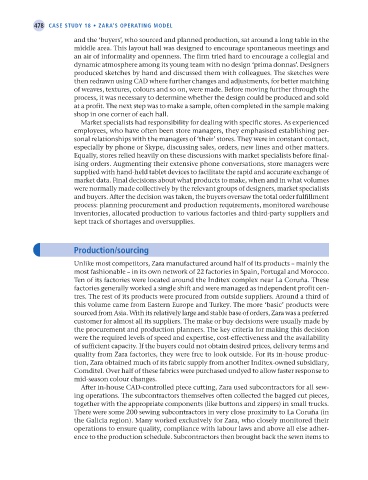Page 503 - Operations Strategy
P. 503
478 case study 18 • Zara’s operating model
and the ‘buyers’, who sourced and planned production, sat around a long table in the
middle area. This layout hall was designed to encourage spontaneous meetings and
an air of informality and openness. The firm tried hard to encourage a collegial and
dynamic atmosphere among its young team with no design ‘prima donnas’. Designers
produced sketches by hand and discussed them with colleagues. The sketches were
then redrawn using CAD where further changes and adjustments, for better matching
of weaves, textures, colours and so on, were made. Before moving further through the
process, it was necessary to determine whether the design could be produced and sold
at a profit. The next step was to make a sample, often completed in the sample making
shop in one corner of each hall.
Market specialists had responsibility for dealing with specific stores. As experienced
employees, who have often been store managers, they emphasised establishing per-
sonal relationships with the managers of ‘their’ stores. They were in constant contact,
especially by phone or Skype, discussing sales, orders, new lines and other matters.
Equally, stores relied heavily on these discussions with market specialists before final-
ising orders. Augmenting their extensive phone conversations, store managers were
supplied with hand-held tablet devices to facilitate the rapid and accurate exchange of
market data. Final decisions about what products to make, when and in what volumes
were normally made collectively by the relevant groups of designers, market specialists
and buyers. After the decision was taken, the buyers oversaw the total order fulfillment
process: planning procurement and production requirements, monitored warehouse
inventories, allocated production to various factories and third-party suppliers and
kept track of shortages and oversupplies.
production/sourcing
Unlike most competitors, Zara manufactured around half of its products – mainly the
most fashionable – in its own network of 22 factories in Spain, Portugal and Morocco.
Ten of its factories were located around the Inditex complex near La Coruña. These
factories generally worked a single shift and were managed as independent profit cen-
tres. The rest of its products were procured from outside suppliers. Around a third of
this volume came from Eastern Europe and Turkey. The more ‘basic’ products were
sourced from Asia. With its relatively large and stable base of orders, Zara was a preferred
customer for almost all its suppliers. The make or buy decisions were usually made by
the procurement and production planners. The key criteria for making this decision
were the required levels of speed and expertise, cost-effectiveness and the availability
of sufficient capacity. If the buyers could not obtain desired prices, delivery terms and
quality from Zara factories, they were free to look outside. For its in-house produc-
tion, Zara obtained much of its fabric supply from another Inditex-owned subsidiary,
Comditel. Over half of these fabrics were purchased undyed to allow faster response to
mid-season colour changes.
After in-house CAD-controlled piece cutting, Zara used subcontractors for all sew-
ing operations. The subcontractors themselves often collected the bagged cut pieces,
together with the appropriate components (like buttons and zippers) in small trucks.
There were some 200 sewing subcontractors in very close proximity to La Coruña (in
the Galicia region). Many worked exclusively for Zara, who closely monitored their
operations to ensure quality, compliance with labour laws and above all else adher-
ence to the production schedule. Subcontractors then brought back the sewn items to
Z18 Operations Strategy 62492.indd 478 02/03/2017 14:01

